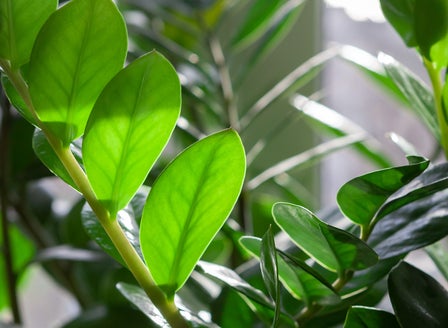Carnivorous plants make for an interesting and unusual point of interest, engaging both young and old alike. Plants such as Pitcher Plants, Sundews and Venus Fly Traps all require similar growing conditions and dietary requirements. Naturally found growing in boggy, low-nutrient soils, they have developed specialised techniques of supplementing their nutritional requirements.
Planting Calendar
Carnivorous plants are available from November to February. This is when they are thriving and enjoying the subtropical weather of Auckland.
Prepare
Position
When grown indoors, Carnivorous plants require bright, indirect light. They can tolerate morning or afternoon sun coming in through the window, although direct midday sun may burn the leaves. More intense light will cause red colouration to develop on Venus fly traps, and intensify the colour of pitcher plants. When grown outdoors provide them with a position in full sun, as long as the soil is kept wet. Some protection from wind is beneficial. Great when planted in a mixed group in a container that has no drainage holes.
Soil
Carnivorous plants are best planted in very free-draining mediums that do not contain any fertiliser. Planting into Peat or Sphagnum Moss is recommended.
Plant
Carnivorous plants can be planted into the ground where the soil is wet, add Peat and Sphagnum moss to assist with moisture retention. Alternatively they can be grown into containers, plant into a mixture of Peat and Sphagnum moss.
Care
Watering
Because these plants come from boggy locations, they have high water requirements. Mediums and soils should retain moisture – planting in peat is ideal. Keep a saucer of water underneath your carnivorous plant; be sure the saucer is always full (except in winter). Mature venus fly traps go dormant in winter, and they need this time to rest meaning the leaves often drop off, reduce watering when this happens, Begin watering again in spring. For plants that are outside ensure that the soil is wet at all times.
Feeding
Carnivorous plants do not need fertilisng as they feed on insects and broken organic matter that they catch.
Spraying
Pitcher plants do not like sprays, with their ability to eat insects there should be no need to spray them.
Pruning
Prune as new growth appears when the weather warms up. Remove any leaves or pitchers that have gone brown.
Beginner Tip
When watering carnivorous plants, use collected rainwater as they dislike the chlorine in water from the tap.
Expert Tip
Pitcher plants go dormant during the cold months of the year, At this time the pitchers go brown. Leave these on the plants until new Pitchers appear then carefully cut the brown ones off. Flowers usually appear before the new pitchers.
Tip
As tempting as it may be, triggering the traps for fun uses a lot of their energy, so keeping your hands away from their traps is recommended.
Top Varieties
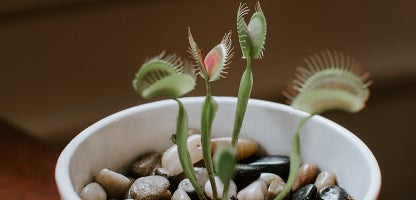
Venus Fly Trap
Venus fly traps have trigger hairs, positioned on each half of their trap. The traps secrete a sweet nectar lure to attract small insects. When any of the hairs are touched three times in quick succession, the trap will close with alarming speed. The trap will then tighten, sealing the small insect in a chamber, to be digested by enzymes released by the plant. After 7-14 days, the insect will be fully digested, and the trap will open again, ready for its next victim.
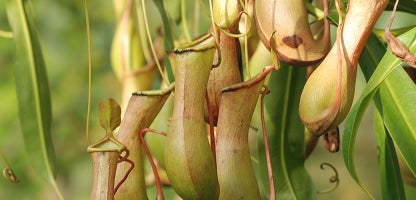
Pitcher Plant
Pitcher plants also use a sweet-smelling lure to attract prey. They attract insects into their deep, slippery throats, where they will soon become exhausted by trying to escape and will eventually drown in the sweet liquid retained in the base of the pitchers. Provided these plants are given the right conditions they will grow successfully indoors or outdoors.
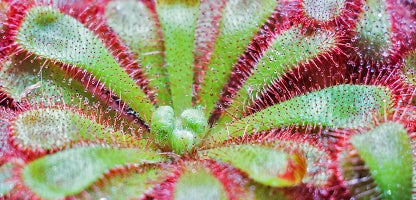
Sundew
One of the largest carnivorous species that have over 190 varieties. They lure insects in with a sweetly scented sticky substance on their leaves called 'Mucilage' which they then use to digest their prey with. These plants are perfect to naturally keep small flies (such as fungus gnats) at bay if they are inside or around moist soil. They also have a winter dormancy period and many will die down for winter.
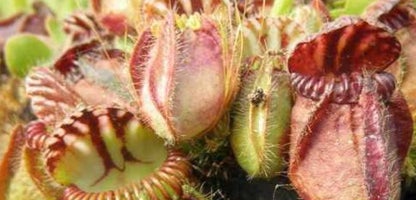
Albany Pitcher Plant
Though not rare, the Albany pitcher plant is a little harder to get a hold of in New Zealand. They look like a miniature version of a pitcher plant, but instead are softer and more delicate, with rounded tear-drop shaped pitchers. These plants are naturally found in the south-western part of Australia and are actually closer related to apples and oaks trees rather than other types of pitcher plants. They thrive in sandier soils.
Frequently Asked Questions
What types of carnivorous plants do you sell?
Kings mainly sells pitcher plants, venus flytraps, 'Albany' pitchers and sundews.
What type of soil should I use for carnivorous plants?
Carnivorous plants are best planted in very free-draining mediums that do not contain any fertiliser. Planting into Peat or Sphagnum Moss is recommended.
How often should I water my carnivorous plants?
Because these plants come from boggy locations, they have high water requirements. Mediums and soils should retain moisture – planting in peat is ideal. Keep a saucer of water underneath your carnivorous plant; be sure the saucer is always full (except in winter).
Why are the leaves of my Venus flytrap turning black?
Blackening leaves can be due to a variety of reasons including overfeeding, poor water quality, or natural dieback as the plant grows. Ensure proper care and avoid feeding it too frequently.
Do carnivorous plants need to be fed insects?
Carnivorous plants do not need fertilisng as they feed on insects and broken organic matter that they catch.
